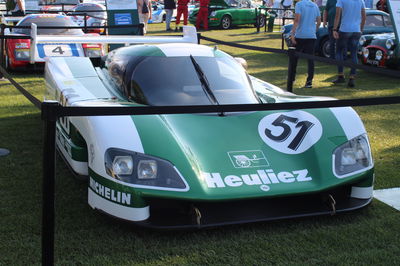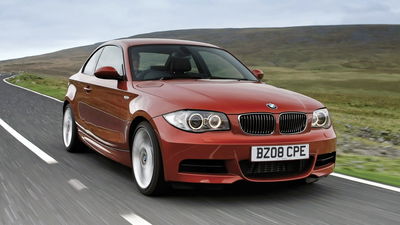10 Weird Uses Of The PRV V6 Engine

Peugeot. Renault. Volvo. Those are the three car companies that came together in the early 1970s to develop a new V6 engine that would power the upper echelons of their ranges of executive cars. The result was the PRV V6, an engine that debuted in 1974 and would stay in production for nearly 25 years.
During that time, it found its way, unsurprisingly, into plenty of Peugeots, Renaults and Volvos, plus the odd Citroen and Talbot, thanks to their links to the ‘P’ part of PRV. But there were so many other applications of it. Famously (or perhaps infamously), the DeLorean had one stuck in the back of its wedgy, shiny bodywork, but we can do better than that. Here are 10 of the weirdest places the PRV ended up.
Lancia Thema

The fact that the Lancia Thema had a V6 wasn’t weird. It was a big executive saloon of the 1980s; of course it had a V6. What was weird was that in the early cars, it was the 2.8-litre PRV. That’s weird because underneath, the Thema was on the same platform as the Alfa Romeo 164, which had a glorious V6 of its own.
Despite the two companies working together, Alfa was seemingly so protective of its own Busso V6 that Lancia had to buy in a six-pot developed by three companies that had nothing to do with the project. That went out of the window in 1986, when Fiat – which already owned Lancia – bought Alfa too, and from 1992, the 3.0-litre Busso was fitted to the Thema.
For a bit of bonus weirdness, the Thema and 164 (and indeed the Fiat Croma) also shared their platform with the Saab 9000, so in a roundabout way, the Thema was actually a Saab with a Volvo engine. Sort of.
Venturi sports cars

French boutique sports car maker Venturi wasn’t some flash in the pan – it had a good go of it between 1984 and 2000, making decent if rare competitors to the Lotus Esprit, before a change of ownership saw it shift towards the nascent EV market.
In a display of Gallic pride (with some extra Swedish flavour), everything it made during this period came with versions of the PRV V6, culminating with the 400 GT which featured the engine in 3.0-litre, twin-turbo 402bhp guise.
Peugeot P4

If you’re looking at the boxy militarised 4x4 above and thinking it looks a bit familiar, you’re not wrong. Developed for the French military, the Peugeot P4 is in fact a licence-built version of the legendary Mercedes Geländewagen, or G-Wagen to you and I.
While the looks were pretty much all Merc (save for the square headlights replacing the G’s round units), the engines were all homegrown. Most used Peugeot diesel four-cylinders, but some – including a rare civilian version – featured the PRV. In fact, some V6 examples even ended up competing in the Dakar Rally.
UMM Alter

The P4 was far from the only off-roader with PRV power, though. A sort of angular Portuguese take on the classic Land Rover formula, these rugged 4x4s never found much favour outside of their home country, but they’re still fascinating things.
For a while, the top petrol engines available were 2.9- and 3.0-litre versions of the PRV. At other points in its life, the Alter also featured BMW straight-six power.
Image: Petertumble, CC BY-SA 4.0
Dodge Monaco/Eagle Premier

This forgettable duo of saloon cars for the North American market resulted from the tie-up between Renault and American manufacturer AMC in the dying days of the latter. The convoluted tale of how they ended up being made involves financial strife, the Renault brand’s withdrawal from North America, an actual assassination and what was left of the AMC-Renault alliance being hoovered up by Chrysler, mainly to get its hands on the lucrative Jeep brand.
The Premier and Monaco were far less interesting than the story that led to them, though. Essentially heavily reworked versions of the Renault 25, the Premier was sold from 1987 under the short-lived Eagle brand, while from 1990, it gained a twin in the shape of the Dodge Monaco, reviving a name that once adorned glorious chrome-laden full-size saloons in the 1960s. The upshot was that the top engine in the Premier (and the only one in the Monaco) was the 3.0-litre PRV.
Schlesser buggy
Told you this engine ended up in lots of odd places. The rear-drive Schlesser buggies were a common sight at the Dakar Rally in the ’90s and ’00s. Developed and driven by Jean-Louis Schlesser, who’d also raced in F1 and endurance racing, they saw their greatest success when powered by the PRV.
In fact, with Renault backing, these buggies won the Dakar outright in 1999 and 2000, while wearing bodywork that was somewhat optimistically designed to resemble a Megane.
WM P88

From one extreme of motorsports to the other, the PRV was also a regular sight at Le Mans in the 1970s and ’80s in the middle of the WM prototypes from independent French constructor Welter Racing.
These cars would have been mere footnotes in the history of endurance racing were it not for the P88. In 1988, this car, with its twin-turbo PRV V6 putting out around 900bhp, set out not to win Le Mans, but to set a speed record. It did just that, hitting 252mph down the Mulsanne Straight before a host of electrical issues forced it to retire from the race. Two years later, the 3.7-mile straight was punctuated with chicanes, and the P88’s record stands to this day.
Image: Éric Manesse, CC BY-SA 4.0
Ultima sports cars

Today, you might know Ultima as a low-volume British company that builds properly mad sports cars powered by enormous Chevy V8s. They’re for the kind of people whose idea of a relaxing Sunday afternoon involves bungee jumping.
Ultima’s earlier cars were a bit more tame, though. Sometimes. The Mk3, for instance, had the same Group C racer looks, but the entry-level engine option was a 3.0-litre, 300bhp PRV. A smaller 2.7-litre version had powered the original Mk1 prototype back in 1983, too.
Image: Phil Parker, CC BY 2.0
Peugeot Proxima concept

The 1980s were a truly wild time for concept cars, as demonstrated by the 1986 Peugeot Proxima. It had a bubble canopy that split in half to allow access, an interior that resembled a cross between a booth at a particularly seedy nightclub and a NASA control room, and a body that looked like a Peugeot 405, a quad bike and a stretch limo had all been involved in some bizarre experiment.
Its powerplant, though, had far more humble origins – though mounted in an exotic mid-engined position and making a claimed 680bhp, it was the 3.0-litre PRV sporting twin turbos. Unsurprisingly, the Proxima remained very much a concept.
Panhard ERC

The Panhard ERC is quite simply a tank. Well, technically it’s an armoured car, but we’re splitting hairs. It still weighs 8.3 tonnes and has a big eff-off cannon on it, plus a couple of machine guns for good measure. And it’s powered by the same engine as a Renault Laguna. Truly, a versatile powerplant.















Comments
No comments found.